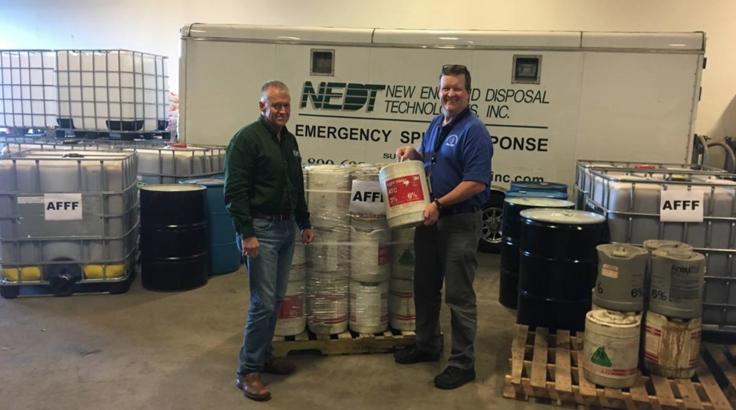- Massachusetts Department of Environmental Protection
Media Contact
Edmund Coletta, MassDEP – Director of Public Affairs

Boston — The Baker-Polito Administration announced today that a new Massachusetts Department of Environmental Protection (MassDEP) program has collected and destroyed more than 149,000 pounds of legacy firefighting foam concentrate from public safety operations across the Commonwealth, ensuring that the chemical contaminants in the foam can no longer pollute drinking water resources and fragile waterways or threaten public health. The legacy foam manufactured before 2003 contains Poly- and Perfluoroalkyl Substances (PFAS) that can cause health issues at low concentrations.
“Old firefighting foams contain PFAS compounds that have been identified as posing a significant risk to human health, so we are proud of this innovative initiative’s success to eradicate these harmful materials,” said Governor Charlie Baker. “This foam take-back program builds on our Administration’s numerous proactive efforts to protect the Commonwealth’s water quality and ensure that residents have access to safe and clean drinking water.”
“We are proud this take-back program has improved safety for firefighters and significantly reduced potential impacts on our natural resources from PFAS contamination,” said Lieutenant Governor Karyn Polito.
The PFAS chemicals are included in the Class B Aqueous Film Forming Foam (AFFF) used by fire departments to extinguish burning hydrocarbons within many types of fuels or other flammable liquids. The AFFF-type foam is often used at airfields when airplanes crash or on roadways when fuel tankers overturn and spill their contents. Once applied at a crash scene, the long-chain version of PFAS chemicals can seep into the ground and contaminate water resources nearby.
“To prevent further impacts to our water quality, it was vital to determine the extent of the legacy foam inventory across the Commonwealth and eliminate it,” said Energy and Environmental Affairs Secretary Matthew Beaton. “The program helped local fire officials remove these old foams from current stockpiles, ensuring they are properly disposed of, rather than used during trainings or firefighting and subsequently released in to the environment.”
The take-back program, operated by MassDEP, with the assistance of the Department of Fire Services (DFS), targeted old foam formulations manufactured before 2003, as manufacturers stopped production of the suspect foams in 2002. Short-chain foam formulations are still in use by fire services.
After DFS contacted every fire department across the state, over the last five months MassDEP worked with 105 fire departments, fire districts and public safety entities to determine the quantity of legacy foam across the state. MassDEP hired New England Disposal Technology, Inc. (NEDT) of Sutton, one of the agency’s hazardous materials cleanup contractors, to remove the legacy foam. In total, 149,016 pounds (or 17,531 gallons) of foam concentrate was transported to a fuel-blending facility in Ohio, which destroyed the material in a state-of-the-art fuel incinerator.
“By partnering with Fire Services, local fire departments and the cleanup contractor, we were quickly able to determine the location of PFAS-contaminated foam and eliminate that threat at no cost to the local fire agency,” said MassDEP Commissioner Martin Suuberg. “The foam take-back program will also go hand-in-hand with our efforts later this year to set drinking water and environmental cleanup standards for PFAS chemicals.”
“This inter-agency partnership greatly benefited local fire departments and communities,” said State Fire Marshal Peter J. Ostroskey.
“We greatly appreciate the help and support we received from MassDEP through the foam take-back program,” said Fire Chief Walter F. Stecchi Jr. of the Joint Base Cape Cod Fire Department.
"New England Disposal Technologies is pleased to partner with the MassDEP and MA DFS to remove the toxic firefighting foam from our critical public safety agencies, safely dispose of it, and prevent their introduction to the fragile drinking water resources and waterways in our state. By all measures the program has been a success," said Michael J. Robertson, President of New England Disposal Technologies, Inc.
MassDEP will continue to evaluate information and ongoing research about the impacts of various foam formulations, and will keep working to identify effective and safe alternatives to PFAS foams. See more information on PFAS and the legacy foam take-back program.
In 2018, MassDEP adopted a drinking water guideline of 70 parts per trillion for five of the most environmentally persistent PFAS chemicals, and the agency plans to review that guidance level during the process of setting drinking water and environmental cleanup standards for all PFAS chemicals. See more information on MassDEP’s efforts to regulate PFAS compounds.
MassDEP has also worked closely with the communities of Ayer, Devens, Hudson, Hyannis, Westfield and West Tisbury where their drinking water supply wells have been impacted by PFAS chemicals, providing technical assistance.
The Baker-Polito Administration has provided over $1.2 billionin loan financing over four years for municipal projects to improve water quality, upgrade or replace aging drinking water and wastewater infrastructure and cut treatment plant energy use and costs.
Top photo:
FIREFIGHTING FOAM TAKE-BACK PROGRAM… MassDEP Emergency Planning and Preparedness Chief Nick Child (right) reviews old containers of legacy firefighting foam with NEDT President Mike Robertson as part of the MassDEP Legacy Firefighting Foam Take-Back Program.
###
